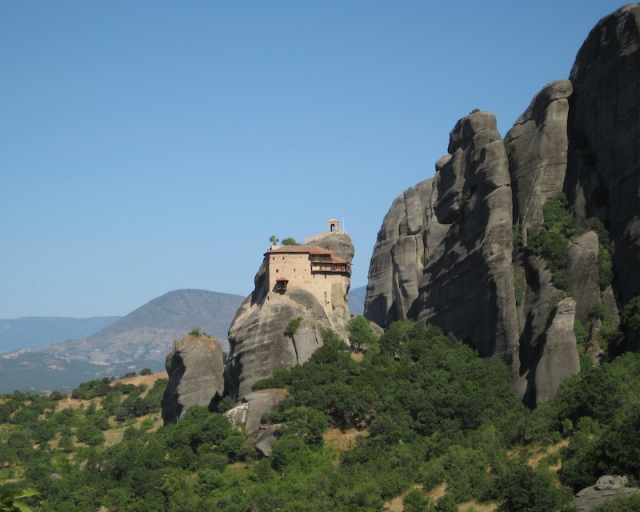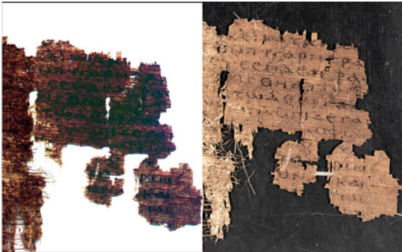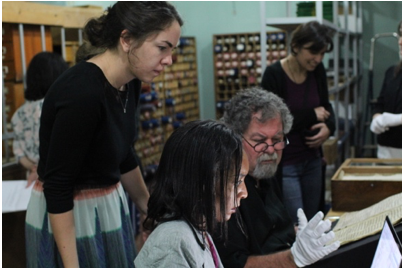Nearly nine decades ago, three of the earliest and most extensive New Testament papyri were made available to scholars through color photographs. These facsimiles, together with their authoritative transcriptions, have remained the primary access that biblical scholars and papyrologists have had to them. Until now. With the multi-volume publication of New Testament Papyri 𝔓45, 𝔓46, 𝔓47 coming out later this year, new, exquisite, exact-size images will become available in print. After digitizing these priceless manuscripts at the Chester Beatty in Dublin and the University of Michigan, CSNTM has collaborated with Hendrickson Academic in the endeavor to offer fresh, library-quality images of these third-century copies of large portions of the New Testament.

The facsimiles will be published both with a white background and a black background, each of which offers different views of the texts. Perhaps surprisingly to many, the black background images were found to be much more helpful for creating accurate transcriptions.
For this initial offering, the transcription of just 𝔓47 will be included with the images of all the manuscripts. 𝔓45 and 𝔓46 will follow in coming years, as the task of transcription still continues. The process of transcribing, however, which has been done in large part on the other two papyri, should yield far more precise results than Sir Frederic Kenyon’s editio princeps of the 1930s. It is no exaggeration to say that thousands of corrections to Kenyon’s transcriptions are in the offing. To be sure, most of these are quite minor, but some are fairly stunning. But every correction to Kenyon’s brilliant but somewhat rushed efforts bring us one step closer to understanding the text of the New Testament in third-century Egypt.
By the use of careful measurements, rigorous comparisons with multiple close-ups of individual letters and ligatures, and intense arguments (!), the editors (Stratton Ladewig, Robert Marcello, and Dan Wallace) are able to offer a new standard transcription of each papyrus. In this short blog, I offer but one animation that lays out our procedure. (Thanks go to my son, Andrew Jon Wallace, for producing this illustration.)
The 28th edition of the Nestle-Aland text in Mark 8:22 reads Καὶ ἔρχονται εἰς Βηθσαϊδάν. Καὶ φέρουσιν αὐτῷ τυφλὸν καὶ παρακαλοῦσιν αὐτὸν ἵνα αὐτοῦ ἅψηται. One variant is listed—Βηθανιαν for Βηθσαιδαν in D and a couple other witnesses. What is not mentioned is the variant for ερχονται. The majority of manuscripts here, along with the key majuscules א* and A, have the singular ερχεται. Kenyon reconstructed the wording of 𝔓45 as having the plural, though underdotting every letter as dubious. But this identification is almost surely incorrect. The space for the word and the shape of the letter fragments fits like a glove for ερχεται. Due to the difficulty of making out the letters in the old plates, one can understand the wrong guess. But with better photographs coupled with the comparisons that digital images readily afford, the CSNTM editors have concluded that 𝔓45 here has ερχεται.
Such may not seem terribly significant. Yet every small decision, every correction, every change to the identification of the text in question gives us a better sense of what these scribes wrote eighteen centuries ago. Further, the singular here does offer a slightly different interpretation on the passage. Although it is true that Jesus and his disciples came to Bethsaida, whether Mark wrote “they came” or “he came” has some significance. On occasion the evangelists use a singular verb with a compound subject. This throws the spotlight on the first-named subject. And frequently, that subject is Jesus (see John 2:2; 3:22; cf. also Matt 13:55; Acts 5.29; 16:31). Mark concludes his pericope on the healing of the blind man with this idiom (Mark 8:27: Καὶ ἐξῆλθεν ὁ Ἰησοῦς καὶ οἱ μαθηταὶ αὐτοῦ). It is a distinct possibility that he would begin the pericope the same way. Such would be a subtle and fitting inclusio in one of Mark’s better-crafted stories. And 𝔓45 might just tip the scales for us to see it.






